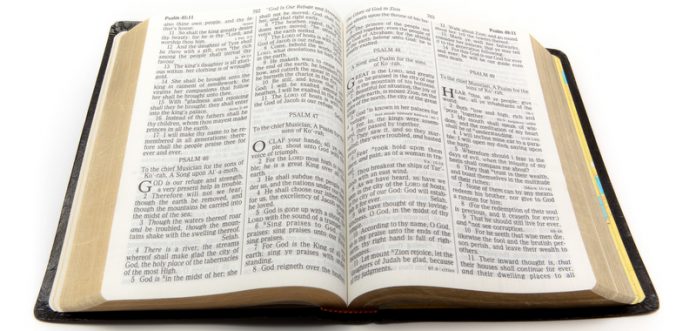
Unleashing the power of God’s Word in your lesson planning
WILLIAM O’LEARY
Are you immersed in Scripture? Do your catechetical lessons drip with God’s Word? If you want your students to encounter Christ, Scripture needs to be more than a verse that you’ve tied into your lesson.
Catechesis aims … at developing an understanding of the mystery of Christ in light of God’s
Word, so that the whole of a person’s humanity is impregnated by that Word (St. John Paul II, Catechesi Tradendae, 20).
Consider how well your lessons are impregnated with God’s Word. In this article, I will share how your catechesis can be soaked in Scripture and thus bring about a more intimate encounter with Jesus Christ.
The foundation — the big picture
Helping students understand the “big picture” of the Bible helps them understand God’s plan of salvation. At the start of each year, I schedule each grade’s syllabus to include a lesson on the story of salvation. It not only gives the big picture of the Bible to students,
but it is also a great reference point for the whole year. Catechists are able to refer back to the story of salvation throughout the year and remind their students of how the topic they are talking about fits into the story of salvation. The Catechism of the Catholic Church gives a great summary of the “big picture” of the story of salvation in its first paragraph:
God, infinitely perfect and blessed in himself, in a plan of sheer goodness freely created man to make him share in his own blessed life. For this reason, at every time and in every place, God draws close to man. He calls man to seek him, to know him, to love him with all his strength. He calls together all men, scattered and divided by sin, into the unity of his family, the Church. To accomplish this, when the fullness of time had come, God sent his Son as Redeemer and Savior. In his Son and through him, he invites men to become, in the Holy Spirit, his adopted children and thus heirs of his blessed life. (CCC, 1)
The story of salvation can also be understood through the various covenants God made throughout history. In the Old Testament, we see covenants with Adam, Noah, Abraham, Moses, and David. And the New Covenant reveals how God the Father’s plan is fulfilled in Christ. The Fourth Eucharistic Prayer summarizes the big picture this way: “Time and again you offered them covenants, and through the prophets taught them to hope for salvation.”
Scripture should form the foundation of all our catechetical activities. An important consideration is that the Word of God is first and foremost a person, but it is also the communication of God to humanity through the written word inspired by the Holy Spirit.
 It is true that being a Christian means saying “yes” to Jesus Christ, but let us remember that this “yes” has two levels: It is consistent in surrendering to the word of God and relying on it, but it also means, at a later stage, endeavoring to know better and better
It is true that being a Christian means saying “yes” to Jesus Christ, but let us remember that this “yes” has two levels: It is consistent in surrendering to the word of God and relying on it, but it also means, at a later stage, endeavoring to know better and better
the profound meaning of this word (CatechesiTradendae, 20).
Marc Cardaronella, director of the Office of Discipleship and Faith Formation in the Diocese of Kansas City–St. Joseph, writes of the importance and desired effects of using Scripture in catechesis.
Spiritual heartburn … that’s the effect you want your catechesis to have. That’s the result of a real encounter with Christ. Scripture facilitates this kind of encounter, but it won’t come from simply quoting a few passages. You need to understand how the Old and New Testaments fit together, how the New is hidden in the Old and the Old revealed in the New, and how the doctrines of Christ and his Church manifest, emerge, and blossom from the interior unity of Scripture. (“The 3 Reasons Why Scripture Is the Heart of Catechesis,” The Sower, 35.4).
Jesus made Scripture central to his teachings
Jesus models how to use Scripture in our lessons. Jesus quoted the Old Testament with great frequency. I did a rough count of the times in the Gospels when Jesus refers to the Old Testament and found more than 60 instances.
Jesus was quoting from Deuteronomy 6:4-5 and Joshua 22:5 when he spoke about the greatest commandment: “Love the Lord your God with all your heart and with all your soul and with all your mind and with all your strength.” And when he spoke of the second commandment that is like the first, he said: “You shall love your neighbor as yourself.”
There he was quoting from Leviticus 19:18. Another example is when he was on the road to Emmaus with the two disciples. The Gospel of Luke describes the scene: “Then, starting with Moses and going through all the prophets, he explained to them the passages throughout the scriptures that were about himself” (Luke 24:27).
Four ways to use Scripture with students
1. Preparation. When you prepare for your lesson, be sure to do the following:
- Ask the Holy Spirit to guide you.
- Read the Scripture reference related to your lesson. (If you use a textbook, there
are usually several recommended scriptural references. Read them and see how you might bring them into your lesson.)
Read the Catechism with regard to the subject matter you are teaching. For example, if your lesson is on the Sacrament of Reconciliation, check out paragraphs 1422–1484. Within those paragraphs, there are approximately 70 scriptural references. This is true throughout the Catechism. The footnotes are packed with scriptural references illustrating how the Catechism also is “soaked in Scripture.”
2. Use Scripture during your opening prayer. Choose a Scripture that connects with the lesson of the day or the liturgical season and the feast or memorial of that day. This helps students see how important it is to turn to God and seek his wisdom and guidance.
3. Have students look up Scripture. Too often, textbooks paraphrase the Scriptures. Although we want to meet our students at their developmental level, try going to Sacred Scripture directly, not using a paraphrase or a “children’s translation.” The primary way to help students become familiar with the Bible is to have them look things up themselves. It may take a little longer to move forward with your lesson, but it is well worth it. When students are looking up Scripture verses, they are learning how to use the Bible and understanding how each lesson is rooted in God’s Word.
4. Close your lesson in prayer using Scripture. Seeking God at the end of your class time through prayer until you meet again — drawing upon the Word of God to direct and lead them — is important. Try assigning students Bible verses to look up and pray with this
week. For example, I’ve asked students to read Psalm 23 every day in the coming week
to see what God is saying to them through it. I also encourage them (and their parents) to read and reflect on the Sunday Mass readings.
All catechists are called to put their efforts into assisting students to become soaked in the Sacred Scriptures. St. Paul spoke of the Word of God as “living and effective, sharper than any two-edged sword, penetrating even between soul and spirit, joints and marrow, and able to discern reflections and thoughts of the heart” (Hebrews 4:12). As catechists, we must be rooted in Scripture so that our lessons may be filled with God’s Word. May the students you teach see your love for God’s revelation through the Scriptures.
William O’Leary lives in Kansas with his wife and three children. He is the Director of Religious Formation for a large parish in Overland Park, Kansas. Over the last 20 years, his work in pastoral ministry has explored ways to draw parents and their children into the practice of their faith. His blog is RelevantCatechesis.com.
This article originally appeared in Catechist, September 2018.
Images: Richard Lowthian, Shutterstock and Mikdam, istock




